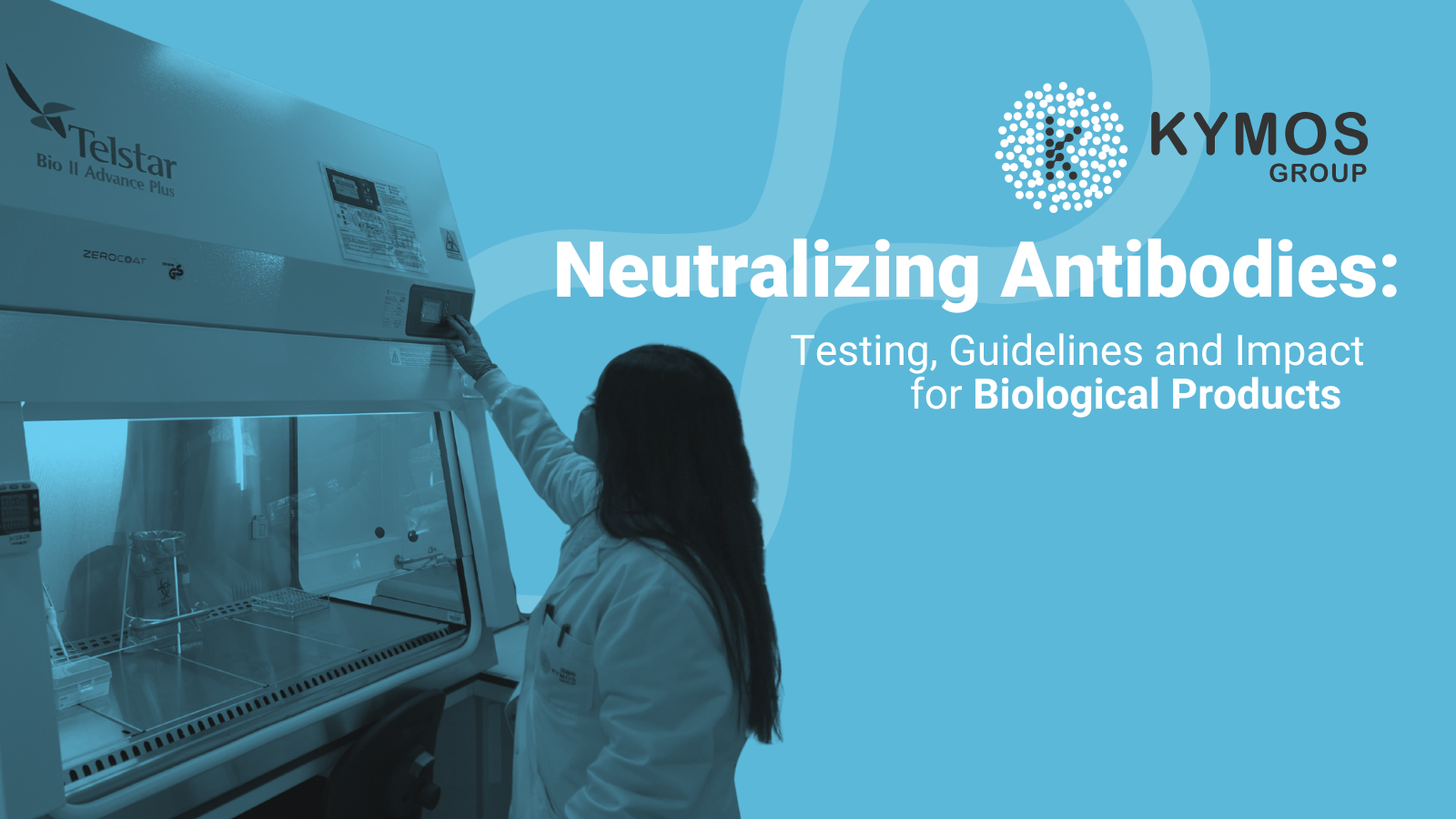
Biologics and Advanced Therapies Medicinal Products (ATMPs) are revolutionizing the future of medicine, and their safety and efficacy are two top priorities. A key aspect of this process is the immune response they may trigger, especially the generation of Neutralizing Antibodies (NAbs). These antibodies have an important impact on drug performance; they can potentially alter and even inhibit their therapeutic action; therefore, immunogenicity testing is a crucial aspect of Biologics and ATMPs development
In this article, we recap what neutralizing antibodies are, why they are important to be tested, how they are detected, the current guidelines to follow for their testing, and how Kymos can support your NAb testing needs.
What Are Neutralizing Antibodies?
Neutralizing antibodies are a specific type of anti-drug antibodies (ADAs). While binding ADAs bind to the therapeutic molecule without necessarily impairing its function, NAbs block the drug’s biological activity, potentially altering its efficacy.
Their presence can lead to reduced therapeutic response, treatment failure, or even adverse effects, especially in long-term or repeated dosing regimens. For these reasons, identifying and characterizing NAbs is essential during drug development.
When Is NAb Testing Required?
NAb testing is typically required for any product that has the potential to induce an immune response, including:
- Monoclonal antibodies (mAbs)
- Therapeutic proteins such as enzymes, hormones, or cytokines
- Gene therapies and oligonucleotide-based therapies
- Oncolytic viruses and viral-vector-based therapies
- Biosimilars
- Vaccines (focused on immune protection response)
The increasing complexity of these therapeutic modalities has made NAb testing more relevant and will continue growing in the coming years.
How Are Neutralizing Antibodies Detected?
NAb detection typically follows a multi-step strategy inside a broader immunogenicity testing framework. The process usually includes:
- Screening for ADAs using a bridging ligand-binding assay (e.g., ELISA or ECLA). Both binding and neutralizing antibodies are detected, but not differentiated at this stage
- Confirmatory test of positive samples to determine specificity to the therapeutic molecule using a competitive ligand-binding assay.
- Titration to semi-quantitatively assess ADA concentration by ligand-binding assay.
- NAb testing only on confirmed ADA-positive samples to determine their functional impact on the drug. In this case, two general formats of assays are employed for NAb testing:
-
- Cell-Based Assays (CBAs): These types of assays are considered the gold standard because they provide a quantitative assessment of functional inhibition of the drug’s biological activity in a cell system (e.g., cell growth, apoptosis, or reporter gene assays). Their physiological relevance makes them the preferred choice by most regulatory agencies.
- Ligand-Binding Assays (LBAs): These are non-cell-based and are typically used when CBAs are not feasible. LBAs are typically competitive binding assays and, while quicker to perform, may be less predictive of in vivo neutralizing activity.
Which Guidelines Apply to NAb Determination?
Neutralizing antibody testing is governed by established regulatory frameworks and guidelines. The most relevant are:
- FDA (2019) – Immunogenicity Testing of Therapeutic Protein Products: Recommends a risk-based approach and supports CBAs as the preferred method. The guideline suggests CBA validation, including sensitivity, specificity, and drug tolerance.
- EMA (2017) – Guideline on Immunogenicity Assessment of Biotechnology-Derived Therapeutic Proteins: Stresses the importance of NAb determination in the drug’s mechanism of action. This guideline requires NAb testing if ADAs are detected and considered potentially clinically relevant.
- ICH S6(R1) (2011) – Focuses on preclinical immunogenicity considerations and supports risk-based evaluation in early development stages.
Conclusion: A Critical Tool in Biologics Development
NAb determination is a critical step in the development and monitoring of biologic therapies, a tool that ensures safety, efficacy and therapeutic consistency in the development of biologic therapies. With the rise of new modality therapies such as gene and cell treatments, understanding and mitigating immunogenicity is and will be essential for drug efficacy and patient safety.
Integrating a robust immunogenicity strategy early in development (and refining it through later stages) can significantly reduce the risk of late-stage failures, accelerate time to market, and support regulatory approval. For this reason, having a trusted partner is vital.
How Can Kymos Support Your Immunogenicity Studies?
At Kymos Group, we offer comprehensive support for immunogenicity testing across all development stages, from early R&D to pivotal clinical phases. With the opening of our new GLP Cell-Based Assay Laboratory in Germany, we’ve significantly expanded our capabilities in biologics, including:
- Complete immunogenicity profiling:
- Binding Anti-Drug Antibodies (ADAs)
- Neutralizing Antibodies (NAbs)
- Expertise in:
- Innovative monoclonal antibodies
- Biosimilars
- Therapeutic peptides
- Oligonucleotides
- Viral vectors and oncolytic viruses
Our teams in both Germany and Spain can support method implementation, validation, or full assay development from scratch, all aligned with EMA and FDA bioanalytical guidelines. Whether your study requires fit-for-purpose exploration or full regulatory compliance under GLP conditions, Kymos provides tailored, science-driven solutions across Europe.
Learn more about our Immunogenicity and Neutralizing Antibodies services: https://kymos.com/services/pre-clinical-clinical-services/bioanalysis-immunogenicity-of-biologics-biosimilars/
Bibliography
- S. Department of Health and Human Services Food and Drug Administration Center for Drug Evaluation and Research (CDER) Center for Biologics Evaluation and Research (CBER). Immunogenicity Testing of Therapeutic Protein Products- Developing and Validating Assays for Anti-Drug Antibody Detection. Guidance for Industry (2019). https://www.fda.gov/media/119788/download
- Committee for Medicinal Products for Human Use (CHMP). Guideline on Immunogenicity assessment of therapeutic proteins (2017). EMEA/CHMP/BMWP/14327/2006 Rev 1. https://www.ema.europa.eu/en/documents/scientific-guideline/guideline-immunogenicity-assessment-therapeutic-proteins-revision-1_en.pdf
- ICH guideline S6 (R1) – preclinical safety evaluation of biotechnology-derived pharmaceuticals (2011) EMA/CHMP/ICH/731268/1998.

